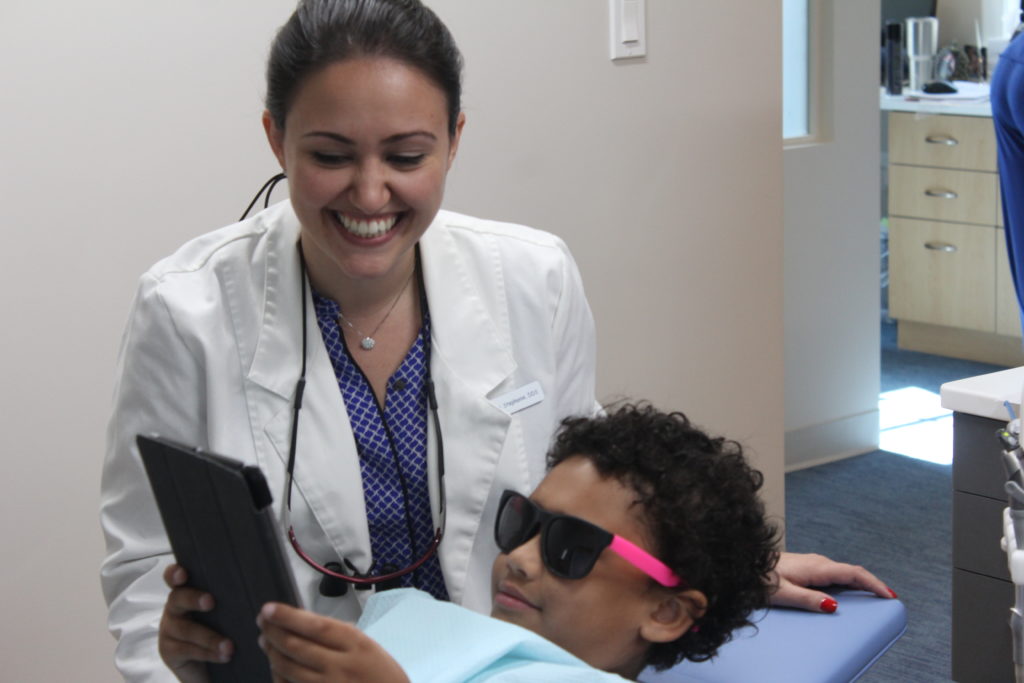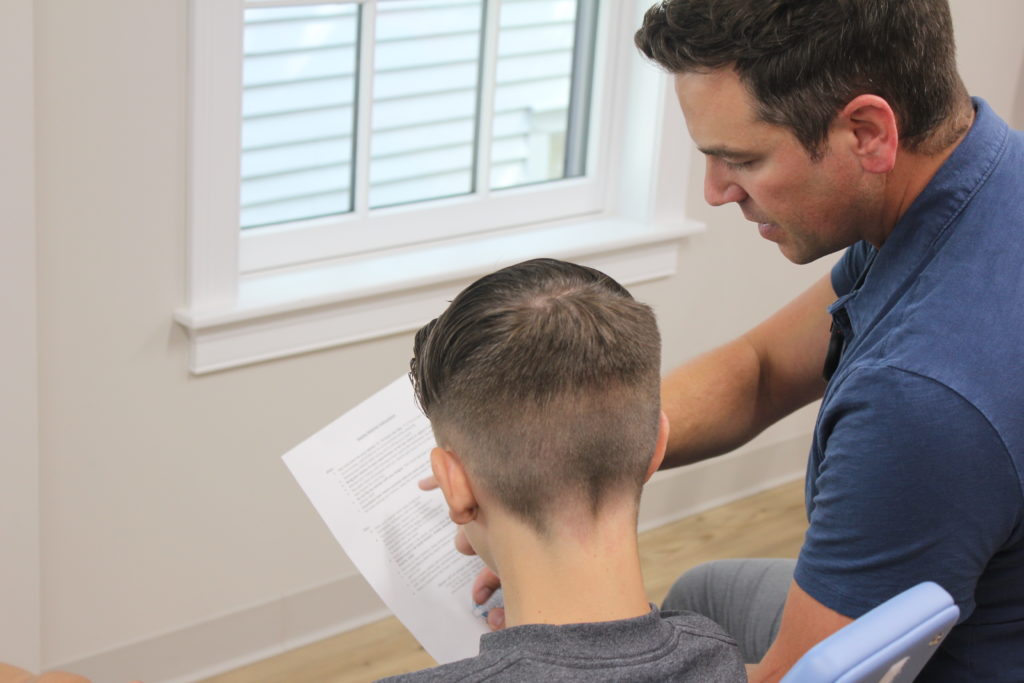Good dental care begins before a baby’s first tooth ever breaks through the surface of the gums. Although they are not visible, teeth begin forming in the second trimester of pregnancy, and at birth, some of the primary teeth are already fully developed in the jaw. The earlier parents begin preventative oral care, the better chance a child has at avoiding dental problems in the future. As pediatric dental specialists, Coppe + Sears are dedicated to giving children the best chance at a healthy smile. Parents can assist in this effort by following the recommendations The American Academy of Pediatric Dentistry (AAPD) has given for helping to prevent tooth decay in babies, children, and teens.
Start good oral habits early
Even before a baby gets his or her first tooth, parents can help clear away harmful bacteria by running a clean, damp washcloth over the gums. As the teeth begin to erupt, an infant toothbrush may be used with water. Once the first molars emerge, ADA-approved fluoride toothpaste may be used in conjunction with a small, soft-bristle brush. It is important to limit the amount of toothpaste used. For infants, an amount about the size of a grain of rice is sufficient. As a child gets older and is able to understand the concept of spitting while brushing, this can be increased to about the size of a pea. Teeth should be brushed twice per day in the morning and at bedtime to remove the plaque bacteria that can lead to decay. Once a baby’s teeth are touching, a parent should introduce flossing. Children younger than six should be supervised when brushing.
First dental visit
Dental visits with Coppe + Sears should begin with the appearance of a child’s first tooth, but no later than their first birthday. These visits allow us to monitor their development and treat any potential dental problems. They also give children the chance to become familiar with our office and our staff. This helps them to look forward to visits as an important and exciting part of dental care as they get older.
A child’s first dental visit is usually short and will involve little or no treatment. Medical and health forms will be completed, and a dental and medical history of the child will be taken. After a comprehensive examination, our dentists will sit with parents and discuss topics such as:
- good oral hygiene practices for healthy teeth and cavity prevention
- fluoride needs
- oral habits, such as thumb sucking, tongue thrusting, and lip sucking
- developmental milestones and potential issues
- teething
- proper nutrition
- the scheduling of dental checkups
During the examination, our dentists will check a child’s teeth for decay, examine his or her bite, and look for any potential problems with the gums, jaw, and oral tissues. Finally, we will attempt to clean the teeth as much as the child permits and apply fluoride varnish.
Fluoride use
Fluoride use in young children can help developing teeth grow strong, and it can help prevent tooth decay in older children. Regular use of fluoride hardens the tooth enamel, making it harder for acid to penetrate, and has been shown to dramatically decrease the risk for cavities. Fluoride in the drinking water is the best and easiest way to get it. Most areas require their tap water to be fluoridated, but not all do. For families whose water supply is not fluoridated or whose children routinely drink bottled water, fluoride supplements may be needed. Our pediatric dentists are able to evaluate the fluoride level of a child’s primary source of water and determine any resulting fluoride needs.
While the AAPD recommends using toothpastes that contain fluoride, and we encourage the use of ACT fluoride rinse daily, this will not be enough to fully protect a child’s teeth. Always check with one of our dentists before supplementing fluoride, since overuse can cause discoloration of the teeth.

Healthy eating habits
A balanced diet can help decrease a child’s risk of developing cavities. Parents should limit sugar-laden foods, juices, and candy that erode enamel and leave behind harmful bacteria. Liquid medicine or gummy vitamins that have been sweetened can be an issue as well. If a child is allowed one of these as a treat, or needs medication, they should be encouraged to brush their teeth and rinse well afterwards to wash away the sugar.
Even babies are not immune from developing tooth decay. Putting a baby to sleep with a bottle can harm the teeth, due to sugars from the juice or milk remaining in their mouth or on their teeth for an extended period of time. These sugars eat away at the enamel, sometimes resulting in pocked, pitted, or discolored front teeth, or in more severe cases, cavities that require teeth being removed. The AAPD encourages parents to switch babies from a bottle to a sippy cup after 6 months of age, and from a sippy cup to a lidless cup by 12 months of age.
Dental x-rays
The AAPD recommends young patients have bitewing x-rays taken every 6 months to 3 years, depending on the individual’s risk for dental caries, or cavities. At Coppe + Sears, we traditionally take x-rays once per year, beginning when a child’s posterior teeth have contact with one another. We will typically introduce the iCAT (cone beam) scan, also known as a panoramic radiograph, when a child has all eight permanent incisors. If a patient later becomes a candidate for orthodontic treatment, this radiograph can be updated. It may be updated again when we evaluate the patient’s wisdom teeth.
Any x-rays taken at our office are patient-based and for the sole benefit of his or her oral health. With contemporary safeguards like lead aprons and digital x-rays, the amount of radiation received in a dental x-ray examination is extremely small. Even though there is very little risk involved, our pediatric dentists are still very careful to minimize any potential exposure to radiation, and we take as few x-rays as possible of every patient.
Regular checkups
As children grow, parents should plan on scheduling routine dental checkups about every six months, depending on our dentist’s recommendations for each individual patient. At each of these checkups, we will complete an oral examination, clean the child’s teeth thoroughly, and apply fluoride. This meets the AAPD requirements, and it also helps us to initiate a positive relationship with our young patients. These regular visits allow us to build a rapport with children, and we are able to use this time to reiterate the importance of maintaining an excellent oral hygiene routine at home, including brushing at least twice a day with fluoride toothpaste, flossing daily, and use of an ACT fluoride rinse. Regular checkups and good dental hygiene can help prevent cavities and the need for dental work in the future.

Working with Coppe + Sears and the AAPD to prevent decay and preserve healthy smiles
Here at Coppe + Sears, we partner with parents to provide education about the basics of oral health care for children, normal dental development, and how to give a child the best chance at a healthy, functional smile. Drs. Mike and Dr. Carolyn Coppe and Dr. Stephanie Karapetian have the training, skills, and experience to make children feel comfortable and at ease during their dental visits, and take pride in connecting with each family they meet with. Should a child develop a need for orthodontics, Dr. Chad Sears is able to provide this service under the same roof, eliminating the need to travel to a second office for treatment. Between our skilled staff and informed parents, Coppe + Sears is able to help children in the Lexington area maintain healthy, beautiful smiles for life.
